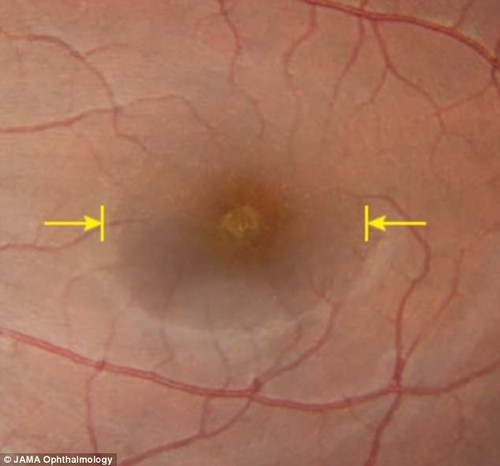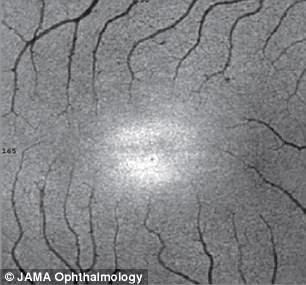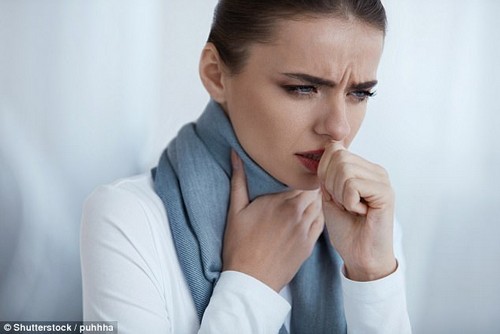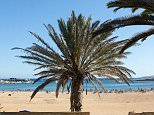Nia Payne, 26, was outside of her boyfriend’s Staten Island office watching the moon pass over the sun like the millions of others around the country this August when she looked into the eclipse for just a few seconds.
A woman who stared into this summer’s solar eclipse now sees a dark spot in the center of her eye as new scans reveal she has a crescent-shaped shadow on her retina.
Six hours later there was a dark spot covering her vision and the next day went to the emergency room. Doctors later diagnosed her with solar retinopathy, eye damage from exposure to radiation.
A new report published today shows a crescent shape on her retina where the damage is worse in her dominant left eye and more manageable in her right.

A scan of Nia Payne’s, 26, interior surface of her left eye shows a light crescent-shaped shadow which was caused by looking into the solar eclipse.


The scan shows more damage done to the outer retina in Nia’s left eye than the right. Nia constantly sees a dark spot in her left eye and said reading is one of the hardest things to do now.
She is training her right eye to be dominant and sits close to the screen in order to watch TV or movies.
WHAT IS SOLAR RETINOPATHY?
Solar retinopathy occurs when the retina has been damaged by harmful rays such as UV rays from the sun.
Light will enter the center of the eye known as the pupil and head towards the back where the retina is located. If that light is a UV ray, then it can burn through the exposed tissue of the retina if the rays are viewed long enough.
The burning of the exposed tissue will destroy cones and rods around the area resulting in a blind spot or color damage in the vision. These cones and rods are important to protect because they are photoreceptors.
Without certain cones and rods in your vision, it is impossible for light to be broken down and processed by your brain. But if Nia stares at the screen for too long, the spot will appear in the center of her eye and block her vision.
After looking into the sun for a few seconds in August Nia said she asked a woman to borrow her eclipse glasses. When she looked through them she recalled that the sun still looked bright and it was as if she was wearing normal sunglasses.
This led researchers to believe that the glasses Nia wore were not up to international safety standards. The American Astronomical Society had warned of unapproved glasses flooding the market, which caused major retailers including Amazon to stop distribution.
The proper glasses meet the ISO 12312-2 standard that reduce the sun’s brightness to a safe and comfortable level and block harmful ultraviolet and infrared rays, according to Rick Fienberg of the American Astronomical Society.
‘Solar filters that meet this standard are about 100,000 times darker than ordinary sunglasses, and sunglasses don’t block infrared radiation,’ he added.
There is no treatment for the condition Nia suffers from and it may improve or worsen, but is a permanent condition.
Solar retinopathy occurs when the retina has been damaged by harmful UV rays.
Light enters the center of the eye known as the pupil and head towards the back where the retina is located. If that light is a UV ray, it can burn through the exposed tissue of the retina if the rays are viewed long enough.
A bright spot in the left middle retina of Nia’s eye is now causing her to see a dark spot, whereas the damage to the right is more manageable.
Researchers from the Department of Eye and Ear at Mount Sinai Hospital in New York used an adaptive optics machine to capture the damage done to her eyes.
The technology looks at individual cells in the photoreceptor layer of the retina, where light is absorbed before it is transmitted to the brain.
It is also the layer that doctors thought to have been the most affected by the sun.
‘We could see a robust concordance between the shape of the exposed sun during the eclipse and the damage to cells in the photoreceptor layer,’ study author Dr. Avnish Deobhakta said.
He said that when patients come in claiming they see dark spots, he has them draw what they see. In Nia’s case she drew a crescent, which corresponds to the amount of sun that was exposed the day of the eclipse.
After taking scans of her eyes, researchers also saw that crescent shape in the photoreceptor layer of her eyes.
Researchers believe these finding may help others.
Dr Quinn, president of the American Optometric Association, told CNN that the case study’s novelty lies in the imaging techniques to characterize and document the retinal damage.
Now Nia is retraining her eyes but said the brightness and glare of lights make it hard, especially at night. She wore sunglasses for the first two months after the eclipse because everything seemed brighter.
The spot she sees isn’t as dark, but now matches the color of whatever she looks at.
Internationally approved eclipse glasses that block the sun’s UV rays were recommended by The American Astronomical Society and they warned of unapproved glasses flooding the market



